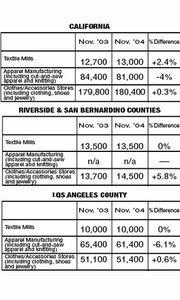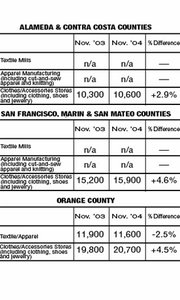2004 Retrospective Apparel, Textile and Retail Employment: Retail, Textiles Among the Brightest Spot
It was no surprise that the number of state apparel manufacturing workers continued to dwindle in 2004, according to the latest data provided by the California Employment Development Department (EDD). But offering a gleam of hope were figures indicating that the circle of clothing and accessories shopkeepers had expanded and the textile mill industry had seemed to stabilize.
In California, the number of apparel manufacturing employees, including those working in apparel knitting mills and cut-and-sew operations, shrank 4 percent to 81,000 in November 2004 from 84,400 one year earlier. The number of people working in textile mills rose 2.4 percent to 13,000 from 12,700 in the same period last year. The number of workers in clothing, jewelry and shoe stores grew less than half a percent to 180,400 from 179,800.
The EDD no longer compiles information on textile mills and apparel manufacturing for the Bay Area, which includes San Francisco and Alameda counties. During the past year, however, the EDD found that clothing and accessories stores hired more workers in Northern California. The number of such workers in Alameda and Contra Costa counties grew 2.9 percent to 10,600, whereas the number in San Francisco, Marin and San Mateo counties in total increased 4.6 percent to 15,900.
In Los Angeles County, the number of textile workers remained unchanged at 10,000. Cheaper costs in China and other countries lured apparel manufacturing jobs overseas, resulting in a 6.1 percent drop in apparel manufacturing employment to 61,400 jobs. On the other hand, retail industry jobs in Los Angeles grew less than 1 percent to 51,400, or nearly double the total number of such workers in the major counties composing the Bay Area.
In Orange County, home to many surf and skateboarding apparel companies, the number of employees in the textile and apparel industries shrank 2.5 percent to 11,600. At the same time, the number of clothing retail workers grew 4.5 percent to 20,700.
Riverside and San Bernardino counties together experienced a 5.8 percent uptick in clothing retail employment to 14,500 jobs. The number of textile workers there stayed constant at 13,500.
To economists, the modest growth in the state’s textile mills was an interesting development, in light of escalating competition from Asia. Jack Kyser, chief economist at the Los Angeles County Economic Development Corp., said that with the imminent abolition of World Trade Organization apparel and textile quotas in 2005, “everybody is going to be holding their breath.” Still, Kyser said there is hope for apparel and textile companies.
“If you have something that is new and you can’t find anywhere else, you will be able to survive,” he said. “You have to continue to invent yourself, even for manufacturing.”
One advantage for small companies is the business tax reform package recently approved unanimously by the Los Angeles City Council and signed by Mayor James K. Hahn. Josh Kamensky, spokesperson for Councilman Eric Garcetti, said the package will provide an across-the-board 15 percent tax-rate cut beginning in 2006. There also will be an increase in the small business exemption, from $5,000 to $100,000, thereby eliminating the gross receipts tax on 62 percent of Los Angeles businesses, beginning in July 2005, he said.
That would give a boost to apparel manufacturers. “Basically, anything you can do to help them is good news,” Kyser said.
—Khanh T.L. Tran
RELATED STORIES
- 2005 Retrospective: Textile Jobs Hold Steady While Apparel Manufacturing Work Continues Decline
- 2006 Retrospective: Textiles Take a Dip, Apparel Manufacturing Jobs Maintain Status Quo
- 2008 Retrospective Declines in California Apparel, Textile and Retail Employment Mirror U.S. Results
- 2007 Retrospective: Retail, Textile and Manufacturing Jobs Slump in 2007























